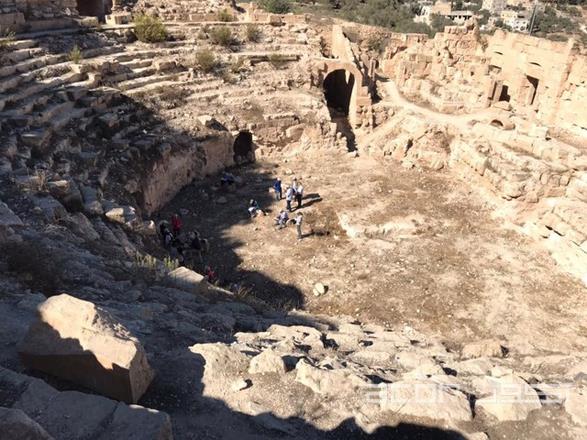
Glass Production, Usage In The Levant: Studying Artifacts From Capitolias
Capitolias was planned as a Roman castrum under emperors Nerva and/or Trajan in 97-98AD. And the name of the city came from the Roman supreme god Jupiter Capitolianus. The city continued to be an important hub during the early Islamic period.
Excavations in Beit Ras have been conducted by an archaeological team from the Polish Centre of Mediterranean Archaeology University of Warsaw, under the direction of Professor Jolanta Młynarczyk.
However, modern archaeological research began in 1983 and continued through the end of the 1980s. It was conducted by Cherie J. Lenzen within the framework of a Joint Excavation Project of Yarmouk University in Irbid and the Department of Antiquities of Jordan.
The focus of the excavation was the city centre that has been now surrounded by modern buildings.
“A fragment of a north–south wall to the southwest of the investigated area, partly visible above the ground, was identified. Recleaning of the western face of this wall now revealed three phases of relative chronology: 1) a small rectangular [water collecting?] basin; 2) north–south wall; 3) later east–west wall,” noted Młynarczyk, adding that its foundation sitting on the edge of the basin, with a threshold visible above. The probable cultural dating sequence is: Late Roman, Byzantine and early Islamic.
Moreover, a roughly circular opening, apparently of a water cistern, was recorded and it was surrounded by mounds of earth, suggesting that at least the top of the fill had been disturbed rather recently by local treasure hunters, Młynarczyk said, adding that the rubble mixed with earth yielded pieces of the clay body of a domestic oven or perhaps a workshop kiln or furnace.
“Traces of charcoal and pieces of slag suggested a workshop [glassmaking or pot-making], while the assorted pottery finds gave a date in the Byzantine and Umayyad periods. Other remains of industrial activities from the surveyed area included many small fragments of handmade rings of clay that had been used most probably as 'separators' between individual vessels placed in a potter's kiln for firing, as well as raw glass chunks and slag pieces with adhering glass 'crystals',” the professor said.
Also collected during the ground survey of the area were mosaic cubes, fragments of marble slabs, roof-tiles, and fairly abundant potsherds, dated from the 1st–2nd through the 12th–13th centuries AD, that is, from the Roman, Byzantine, early Islamic and Ayyubid/Mamluk periods, Młynarczyk continued.
Furthermore, one should bear in mind a number of mentions of wine production and the wine trade at Beit Ras in the 6th–7th centuries and probably later
“The shape and decoration of the wine jars discovered on the floor were typical of the 7th century rather than late 7th-to-8th centuries and the Byzantine date of this deposit of wine jars is confirmed by single examples of fine wares like the rim of a Jerash,” Młynarczyk explained.
Also, traces of destruction of stru ctures at Beit Ras might have occurred during Byzantine –Sassanid war (602AD-628AD).
“In the middle of the southern edge of the trench, a heap of both dressed blocks and irregular stones was initially interpreted as a would-be part of a dismantled well; however, it soon became evident that it was a makeshift boarding of a water cistern [rather than a well],” Młynarczyk underlined, adding that its original opening was cut into bedrock, most probably during the first habitation period.
This water installation was then reused only after the place had been abandoned, most probably due to the earthquake of 749AD.
“Although the quantity of glass finds from Beit Ras would appear relatively small in comparison with other sites, its significance lies in the fact that this is the first published glass assemblage excavated in this particular city and thus contributes significantly to a general picture of glass use and production in this region,” Mariusz
Burdajewicz, from the University of Warsaw, explained.

Legal Disclaimer:
MENAFN provides the
information “as is” without warranty of any kind. We do not accept
any responsibility or liability for the accuracy, content, images,
videos, licenses, completeness, legality, or reliability of the information
contained in this article. If you have any complaints or copyright
issues related to this article, kindly contact the provider above.


















Comments
No comment